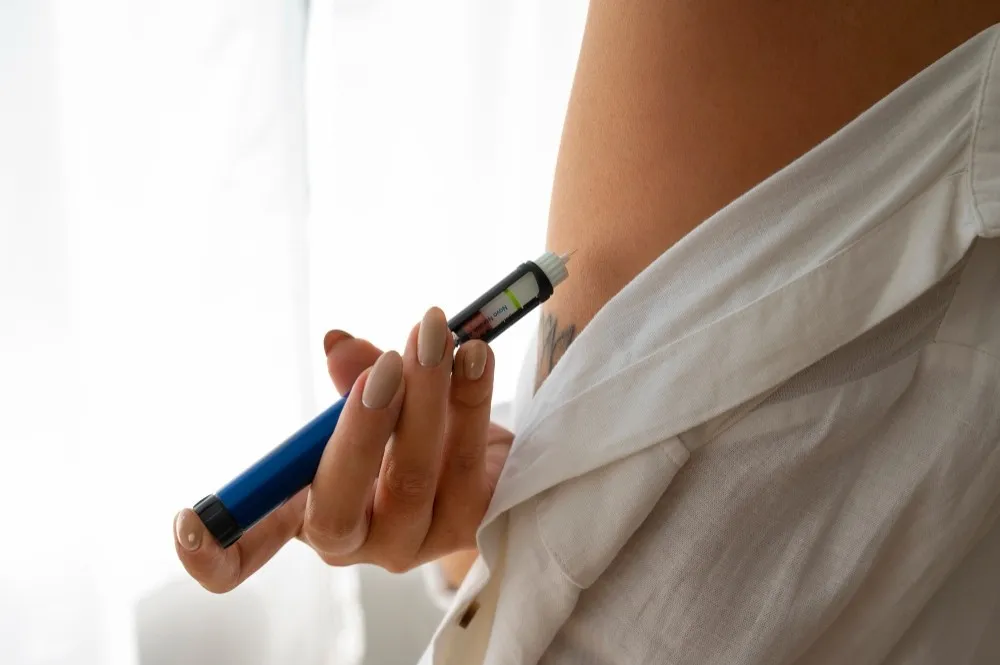Glucose is the foremost source of energy in our body. Our system breaks down and utilizes fats and proteins for energy only when there is an extreme shortage of glucose stored in the body. Lack of glucose in the body can even lead to serious conditions of delirium, delusion, and unconsciousness, as is seen in many young children and adults who go to school or work by skipping breakfast. But do you know what sugar levels are normal?
Normal Blood Sugar Levels in Adults typically range between 70 and 100 mg/dL when fasting and less than 140 mg/dL after a meal. These levels can vary depending on the individual and the time of day. It is important to note that levels outside this range can indicate a problem, such as Diabetes or Prediabetes, and should be further evaluated by a healthcare professional. Since glucose is a unique part of our lives, let us understand the normal glucose levels in our system and what happens when there is a negative blood glucose level fluctuation.
What Are Normal Blood Sugar Levels For Adults?
The normal blood glucose levels in a person without Diabetes are as follows:
- Fasting blood glucose (FBG)- 80-90 mg/dl
- Pre-meal- 70-90 mg/dl
- Postprandial- 100-140 mg/dl
- 24-hour glucose- 89-105 mg/dl
The normal blood sugar level in a person diagnosed with Diabetes (Type 1 and Type 2) is as follows:
- Fasting blood glucose (FBG)- 90-100 mg/dl
- Pre-meal- 80-130 mg/dl
- Postprandial- 100-180 mg/dl
- A1C- 6.5%
The normal blood glucose in expecting mothers is as follows:
- Fasting blood glucose (FBG)- 90-100 mg/dl
- Pre-meal- 80-130 mg/dl
- Postprandial- 120-140 mg/dl
- A1C- 6.5%
When should I check my blood glucose levels?
A good measure of the normal glucose levels in the blood can be done over a series of tests throughout the day or by performing any of the tests typically designed to test for normal glucose levels in the blood.
- Fasting glucose is the blood glucose level measured after keeping a fast for 8 hours. This is usually tested early in the morning after ensuring that you have dinner roughly 9 hours before the test.
- Pre-meal - the blood glucose level will always be the lowest just before a meal (mostly lunch). The test is taken just before having your daily lunch.
- Post-prandial - the test is taken about 1-2 hours after a meal. This is the highest glucose level you will observe since there is a sugar spike right after a meal.
- 24-hour glucose the average glucose level is calculated throughout the day (taking the tests mentioned above)
What Tests are performed to check glucose levels?
Two newer methods of testing blood sugar are currently being used to test for blood sugar levels in diabetic and normal people. These are,
1. A1C
This is Hemoglobin A1C. This hemoglobin binds to sugars when they are present in the bloodstream. A measure of A1C thus discloses the amount of sugar in the blood. This test used to be the gold standard for measuring blood glucose levels in diabetic patients.
Also Read: HbA1c Normal Range: What You Need to Know About Blood Sugar Control
2. Time-in-Range - Blood sugar normal range
This is the new gold standard for measuring blood glucose. It involves calculating how long a person stays within the normal range of blood glucose levels.
What affects normal glucose levels for adults?
If you do not consume carbohydrates for an entire day, your normal blood sugar level will drop. Low blood sugar can also have serious side effects, such as fainting, numb limbs, slurred speech, and even a hypoglycemic coma. Thus, normal blood glucose levels can only be maintained and stabilized by consuming a healthy portion of carbohydrates or sugars.
A few factors that affect normal blood glucose levels are:
1. Foods you consume
Foods have a significant impact on your blood glucose. Foods with a high glycemic index, such as sugar (100- standard), bread (97), oats (87), and white rice (64), when consumed every day will raise your normal blood sugar levels drastically as compared to foods with a low glycemic index such as broccoli (15), Spinach (15), apples (36), yogurt (14), rice bran (27). Choose your food wisely.
2. Meal timings
It is observed that eating small portions spaced over 7 meals a day maintains normal blood glucose levels, compared to eating large portions spaced over 3 meals a day, which gives a higher sugar spike after every meal.
3. Exercise
A low-intensity workout can deplete your glucose stores. At the same time, a high-intensity workout raises glucose levels since more energy is required for a high-intensity workout session.
4. Underlying disease
Diabetes is a condition that is synonymous with high blood sugar. If you are diagnosed with Diabetes, you will likely have high blood glucose that needs to be controlled using externally injected insulin or tablets.
5. Medications
Some medications, such as steroids and beta blockers, can affect glucose levels. Thus, normal sugar levels for adults can be affected by different medications.
6. Sleep pattern
Not sleeping long enough or not sleeping long enough in a single period raises blood sugar levels since your body does not metabolize the sugars.
7. Hormonal changes
Changes that occur during pregnancy, menopause, or other stages of life can affect glucose levels.
What happens when blood sugar is not normal?
Once you know what is the normal sugar level, you can check easily if your blood sugar level is not normal. As mentioned earlier, it is important to maintain your blood glucose levels to maintain the body's stability of energy. Diabetes is characterized by the inability of your body to naturally bring down glucose levels, thereby leaving extremely high glucose levels in the blood.
Diabetes type 1 is a genetic condition where the pancreatic cells of the individual do not secrete insulin for normal functioning. Type 2 diabetes is an acquired condition wherein the cells are resistant to the action of insulin, and the blood glucose levels remain high.
Various factors contributing to type 2 diabetes are obesity, overweight, hormonal disorders, or insulin resistance. In either case, patients strive to medically bring down blood glucose levels by using synthetic injectable insulin or blood glucose-lowering tablets such as Metformin and Glimepiride.
Bottom Line
Blood glucose levels constantly fluctuate depending on what you eat and how you sleep. This is not something to worry about. However, it is a serious concern if you constantly keep your blood glucose levels high by eating excess sugars and not having a healthy lifestyle. Maintaining normal blood sugar levels for adults is crucial, as processed sugars can be harmful in the long run, while a diet that is too rich in carbohydrates can also be equally damaging to your system. Be careful of what you eat because your body can only be as healthy as the foods you consume.
Also Read: 14 Lifestyle Changes for Managing Diabetes
Frequently Asked Questions
What is high blood sugar harmful to health?
A constant high level of sugar in the system means a constant flow of energy usage that can lead to severe conditions such as it can damage the blood vessels and disrupt blood flow can result in obesity over long periods, damage to the blood vessels in the eye and impair your vision among many other serious disorders.
What is the normal blood sugar after food?
After a meal, the normal blood glucose level for persons without Diabetes must fall in the range of 99-137 mg/dl. The normal blood glucose levels for a diabetic patient fall in the range of 90-160 mg/dl.
Which foods raise blood glucose levels?
Foods that contain more than 70% carbohydrates, such as rice, bread, oats, baked potatoes, muesli, and fruits, have an extremely high glycemic index and immediately raise glucose levels in the blood.
What is normal sugar level in human body?
The normal level of sugar in human body are between 70 mg/dL (3.9 mmol/L) and 100 mg/dL (5.6 mmol/L).
What is the normal range for diabetes?
The normal range for fasting blood sugar levels is typically between 70 and 100 milligrams per deciliter (mg/dL), while for HbA1c, a value below 5.7% is considered normal.
What is a normal blood sugar level after meal?
The healthy blood sugar should be less than 100 mg/dl without eating anything. But normal blood sugar level post meal should be not less than 140 mg/dl after 2 hours of eating a meal.
What is a normal blood sugar level before meal?
It should be less than 80-100 mg/dl before meal.
What should blood sugar be 3 hours after eating?
A person without a history of diabetes recorded less than 125 milligrams per deciliter after 3 hours of eating.
What is the sugar normal level after food?
The blood sugar level should be between 140 - 180 mg/dl. If you notice more than 200 mg/dl after 2 hours of eating. You should consult to your doctor.
Is 200 blood sugar normal after eating?
According to ADA, the general goal is to maintain a blood sugar level is less than 180 mg/dl. If you still notice the blood sugar level on the higher side, inform the doctor.
What is a good fasting blood sugar level?
The normal fasting blood sugar level chart is between 70 mg/dL and 100 mg/dL.
What should I do if my sugar level is 350 after a meal?
According to the University of Michigan, more than 300 mg/dl is dangerous. It can be a life-threatening condition. If you feel drowsy contact your doctor immediately.
What is the high sugar level range?
It should be more than 140 mg/dl.
My blood sugar is over 200 what should I do?
Contact your doctor or care team to normalize your blood sugar level.

Reviewed by







